Inspiration: A family member once said "I only believe in minor evolution and minor changes, it is impossible for things to turn into entirely other things"
Method: My plan is to create a plausible step by step story of our ancestors from single cell life to humans including the development of limbs and organs and what drove them to be created. My goal is to make each step small enough and explained enough where the average person can look at it and say "I see how that is a minor evolutionary change and is plausible". I included all 6 major extinction events and how they influenced our ancestors evolution, as well as how and why organs formed. The most basal species discovered so far at each branch of the tree of life has been selected for this story. In a couple cases, the most basal creature discovered so far is virtually identical to the actual basal creature that is our ancestor, and is selected simply because it is the best choice available, and is practically the same. (XXX mya) refers to how many million years ago the event or species first occurred.
Problem: Large parts of evolutionary history involve best guesses from scientists mixed with undisputed facts. Large parts of the information below are from discoveries after 2012 when DNA sequencing became affordable, and large databases were able to be compared by many scientists. If you were to ask a scientist to create such a story as the one I have, they would feel the need to preface everything with qualifiers to indicate their level of uncertainty. Instead the story that follows will, for the sake of story and demonstrating the plausibility of evolution, be written as if the leading scientific facts, theories, and guesses are all proven. The theory of evolution will never attempt to explain the origin of life, but for the sake of starting our story and creating the first cell, it will begin with the best guess from another field of science.
Earth transitions from lava to nearly magma free surface with water. The sky is orange due to the high methane content.
The entire time the earth is being bombarded by rocks containing amino acids.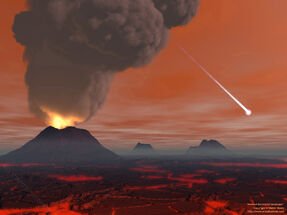 (4600-4100 mya)
(4600-4100 mya)
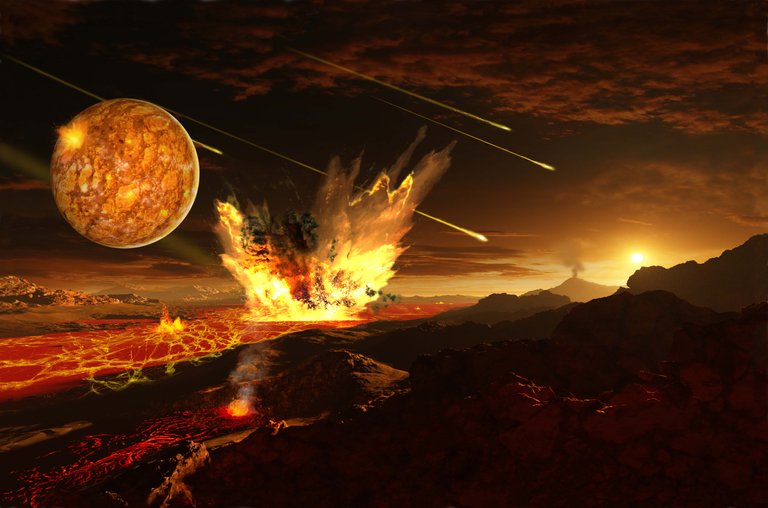 (3900 mya)
(3900 mya)
The Late heavy bombardment of the inner solar system planets take place. Like monkeys typing Shakespeare, after hundreds of millions of years of the components of life colliding eventually manage to produce a basic single cell organism capable of reproducing. It is a froth of bubbles and RNA called Protobiont:
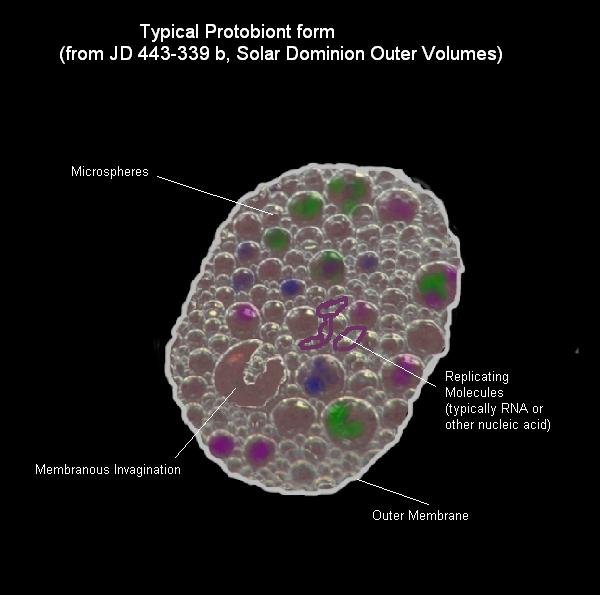 (3900 mya)
(3900 mya)
Protobionts accrue 300 million years of replication and more survivable variations. It eventually develops to a much less random replication and uniform internals such that it can be called Bacteria:
 (3600 mya)
(3600 mya)
Meanwhile in regions of extreme temperature conditions, protobionts take on another smaller form, one that is able to better handle the heat by using a weaker flexible membrane and more complex RNA and are called Archaea:
 (3400 mya)
(3400 mya)
As they relentlessly multiply the competition increases, and after a billion years of experimentation, Arcaea evolve to be invasive to bacteria and survive inside them as endosymbionts. Invasive Arcaea that keep the bacteria alive as opposed to killing them become more prevalent by keeping the host alive. Invasive Arcaea improve and enter into a symbiotic relationship with bacteria and are now called a nucleus. Bacteria now have a nucleus. The first Eukaryote is formed:
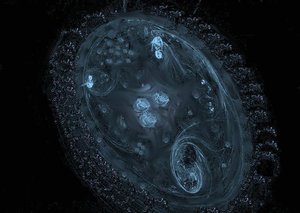 (2000 mya)
(2000 mya)
Now possible to due to the appearance of the nucleus, the first widespread virus appears. The virus enters bacteria fusing its own RNA with the RNA in the bacteria forming the first DNA. Enabled by the information capacity of DNA, life becomes more complex. Sexual reproduction begins for the first time. Those that developed a method of obtaining food faster than waiting for it to float by flourish. The new swimming life-form is called Choanoflagellate:
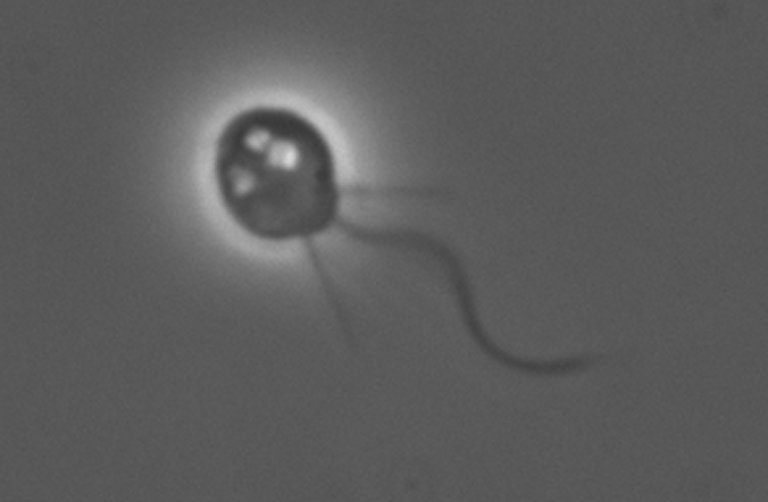 (900 mya)
(900 mya)
Some Chonoflagellates attach to the ocean floor and each other. Working together they can collectively create stronger currents increasing the rate of coming in contact with food as compared to swimming freely. They soon develop stems to connect groupings allowing for even larger groups and even more food. The new life form is called Proterospongia:
 (700 mya)
(700 mya)
Proterospongia over time developed a more complex and efficient layout to maximize the gathering of food. Eventually this produced the first differentiated tissue. Most formed protective protein shells like on modern sponges, and some did not. With very little limiting the quantity of cells, it quickly turns into large visible structures. Early versions like the 600 mya fossil below did not have a consistent organization of cells. This new life form is called Sea Sponge:
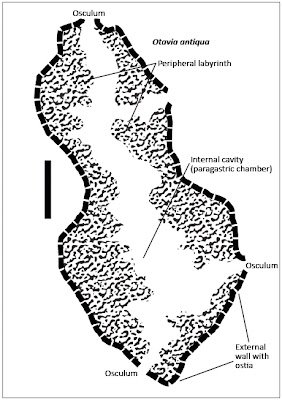
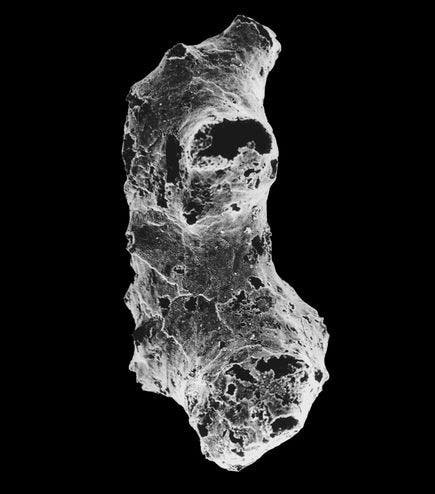 (600 mya)
(600 mya)
The sea sponge eventually evolved to communicate between cells so they can pump in unison allowing for an even higher rate of food gathering. This gives rise to the predecessor for muscles, the hydrostatic skeleton which operates by having dedicated cells contract in unison to fill tiny water chambers changing the overall shape. Eventually a sponge that happens breaks free of its ocean floor attachment that is able to survive. Cells pumping in unison, it begins to swim again for the first time in 220 million years. But this new life form is not capable of completing its entire life cycle unattached from the ocean floor. When it reproduces, the resulting larva attaches to the sea floor like its sponge ancestor. These then grow into an adult and break free again. The main driver thus far in the evolution is to get food filled water moving past cells as fast as possible, being able to swim takes it to the next level, and it is not long before hydrodynamic shapes dominate. The new life form is called a Jelly Fish. Jelly fish today still follow the same life cycle never letting go of the sea floor requirements of their sponge ancestors.
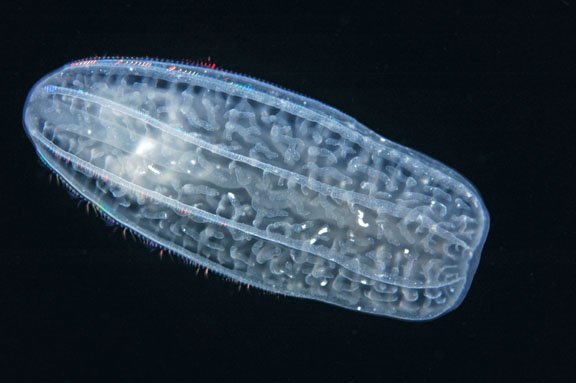 (580 mya)
(580 mya)
Some jellyfish became more streamlined in the search to obtain food faster. They are now called a Gastrotrich:
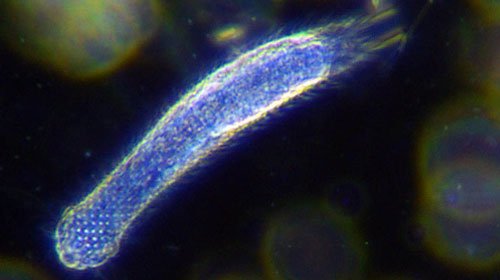 (570 mya)
(570 mya)
As the drive for movement speed pushes on, it becomes more and more streamlined, and soon there is lacking surface area for every cell to get exposed to nutrients and oxygen, and propulsion by expelling water begins to become inefficient and the animal slowly turns towards swimming more like an eel, the lack of water flowing in and out of the organism forces a need for a forward facing mouth. Any further streamlining turns into flattening because only a few layers of cells are able to get oxygen and nutrients. A very basic light sensor develops. Very simple reaction cells form attached to the light sensor that allow the animal to swim faster when sudden changes to light happen which would indicate danger. It is now called a flatworm:
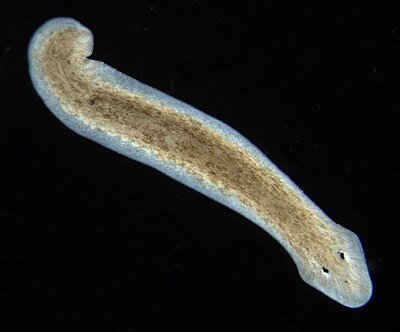 (550 mya)
(550 mya)
Around this time many competing life forms are also generating the basic prerequisites such as internal organs to enable varied and diverse life forms. In addition and the climate and atmosphere of the world is changing. Oxygen was not present until recently, and is now becoming abundant. Most of the planet was covered in ice yet now is warming up, underwater volcanic activity is filling the water with previously absent calcium needed for bones and shells. All of these stars aligned simultaneously causing the Cambrian explosion, an expansion of life and diversity so extreme, so fast that scientists were convinced it was the beginning of life until the 1960s.
 (540 mya)
(540 mya)
Solving the problem of only a few layers of cells able to get oxygen, the first simple circulatory system forms. At first this circulatory system simply uses cilia to push ocean water through tubes. Increasing movement speed further, it developed a basic tail fin. Rows of segmented muscles run down either side of the animal, and grow in size to accommodate the increased power needed by the tail fin. The nervous system coordinating cell movement centralizes itself between each row of muscles connecting every muscle with the shortest path possible. This primary cable running down the top of the animal also connects to the light sensor in the front. This forms the first spinal cord. A swell develops near the mouth to handle converting light input to muscle movement in basic but slightly more complex ways ways; the first brain. Large Tentacles form around the mouth opening to help direct food in. A series of appendages grow on both sides of the front of the fish, precursors to gills. At 1.5 inches in length, the animal that made vertebrates possible, is called Pikaia.
 (530 mya)
(530 mya)
The tail fin grows up the top and bottom of the body providing more propulsion and control. Calcium, now abundant and being used by many animals, is incorporated into the body structure of the animal protecting the critical nervous system, and increasing leverage of muscles thereby also increasing speed yet again. Taking advantage of the ever increasing oxygen levels, the appendages near the head evolved into gills. The basic eyes grew bigger and more useful increasing ability to hunt food and the brain increased in size with it. Additionally the digestive system begins to form. At first there is no stomach, just simple glands along the tract that release acid to aid in the digestion process. The circulatory system becomes entirely internal and no longer freely allows outside water to enter. The first liver forms giving a dedicated organ to filtering and modifying blood composition. The result is the first vertebrate, a jaw-less fish called Haikouichthys:
 (525 mya)
(525 mya)
For the last 100 million years the entire planet was an intense greenhouse. A combination of natural cooling and an increase in volcanic activity led to a decrease in oxygen in the oceans, and global cooling enough for ice caps to reform. The freezing caused the sea level to drastically drop, exposing and killing almost all life on the continental shelves. 85% of all marine species perished. This time is known as the Ordovician–Silurian extinction events
 (444 mya)
(444 mya)
To cope with the decreased availability of oxygen in the water, fish developed a 2 chambered muscular heart to aid in pumping blood, and a cavity that could be opened and closed to pump water across gills at a higher rate than swimming would provide. Bones expanded to incorporate more leverage on this buccal cavity ultimately forming the first jaw. Fins grew on the sides of the fish for stability and precise positional control. Jaws at first were only used for increased leverage for drawing water past gills, but since they happen to be in the right location for catching prey they are used for this and eventually develop teeth to be better at it. The digestive tract begins to slow down the progression of food in a chamber called the stomach using the existing digestive glands. The result is the first Fish:
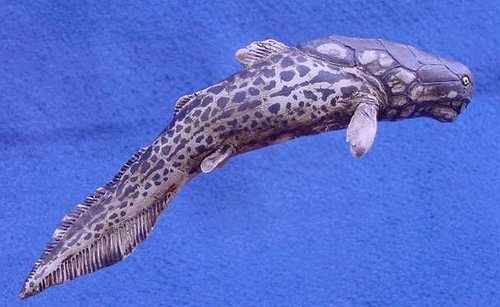 (430 mya)
(430 mya)
 (418 mya)
(418 mya)
Flourishing with food yet absent of predators the shorelines became a trove of food for any predator capable of surviving in shallow water. Fish pushed the limits for shallow water, and the key to success was the ability to be partially out of the water. Muscular fins to slide around in shallow waters developed. The shallow water also gave advantage to fish with less height and that were less visible to prey. As a result, muscular, longer fins formed and heads became flatter. With the increased variety of environments, came the requirement of more complex decision making and thus a larger brain. Terapods came about. Ancestor Titaalik:
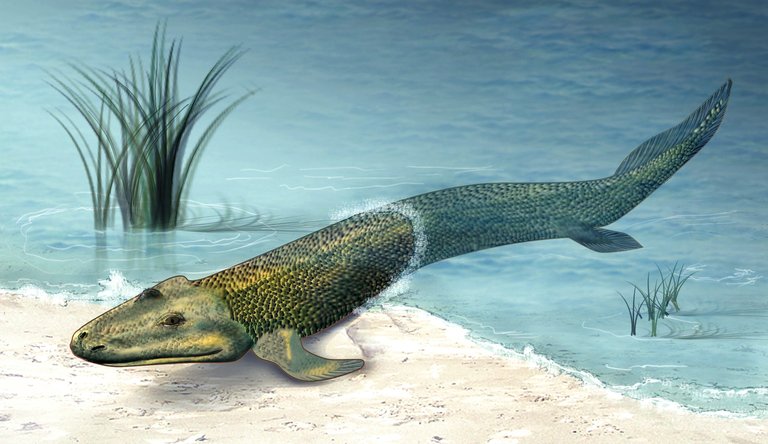 (375 mya)
(375 mya)
As Pangea began to form together, volcanic eruptions increased dramatically severely reduced the amount of oxygen in the ocean. This resulted first in a massive temperature increase and sea level rise, followed swiftly by a massive temperature decrease and freezing that caused a drop in sea levels exposing and wiping out virtually all coral. The lack of oxygen drastically decreased the usefulness of gills and increased evolutionary pressure to be able to survive on land. 97 per cent of vertebrate species disappeared, with only species under 1 meter surviving. Meanwhile land plant species had for the first time evolved both vascular systems and seeds, increasing the max size of a plant from 30 centimeters to 30 meters. Never before seen massive root systems were created releasing massive amounts of nutrients stored in the soil for millions of years into the rivers and ocean, which caused an explosion of algae, which in turn further reduced oxygen in the ocean.
 (360 mya)
(360 mya)
After enough time exposed to a near land environment, the bones in the base of the fins extend out with the fin material still present creating webbed feet with 8 digits. Due to the low oxygen conditions of the shore side pools, the walls of the swim bladder developed the ability to absorb oxygen creating the first lungs. Additionally, the heart increases to 3 chambers increasing the purity of oxygenated blood leaving the heart, but like the 2 chambered heart it still expels a mixture. Due to partial buoyancy weight now being supported on and off, the beginnings of a pelvic bone start to form. It is called Acanthostega:
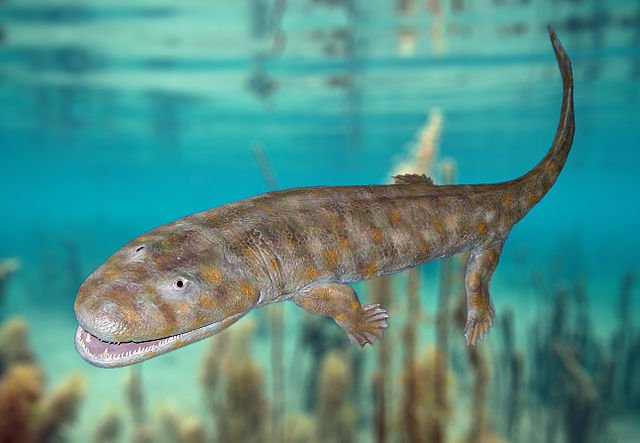 (365 mya)
(365 mya)
Due to increased time spend on land the following happens: Developed a ribcage to allow it to support the weight of its body on its organs. Developed egg laying to be able to lay eggs on land where there are no or less predators. Developed a larger brain that allow identification of good egg laying locations. Ankles and elbows unfused allowing for greater mobility. After 35 million years with 8 digits, the number of digits reduced to 5. Claws developed on the ends of digits to protect them from the wear of walking on land. Despite all of these changes it still spends less than half of its time on land and uses its gills under water. The first generation is called Casineria:
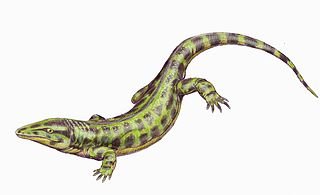 (340 mya)
(340 mya)
Skin changes to be able to handle the lack of contact with water. Gills used for the last 222 million years are finally no longer needed and disappear. Lungs develop to be more complex and efficient. Ear holes develop behind the eyes, at first it is simply a hole in the skull to allow the skin to better detect vibration in the air. The brain grows yet again, to incorporate air vibration into decision making. Legs grow longer for faster movement. It moves to the forest. The first Synapsid is disputed via contradictory information on wikipedia as possibly being Archaeothyris, however the size and shape of the another disputed candidate more closely fits this evolutionary tree, the Echinerpeton:
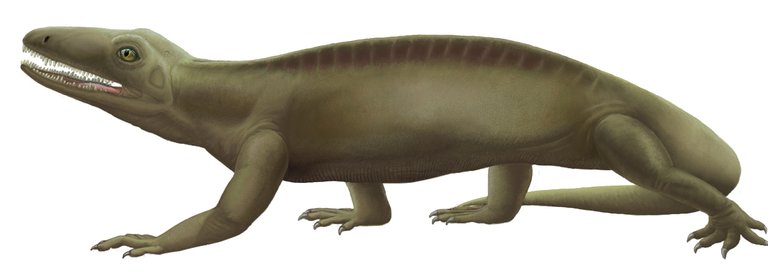 (308 mya)
(308 mya)
It evolved differentiated teeth, a hard roof to the mouth, increased jaw muscle size, increased size of openings in the skull near the ears, and the front cutting teeth became equal in size forming what is likely the first Therapsida, Tetraceratops:
 (275 mya)
(275 mya)
With the appearance of large predatory dinosaurs, Therapsids were forced into the night, developing the ability to detect smells without tasting the air, larger eyes, and an brain to support the intelligence to avoid dinosaurs. It was a medium-sized predator, similar in size to a large dog. It is called Biarmosuchus:
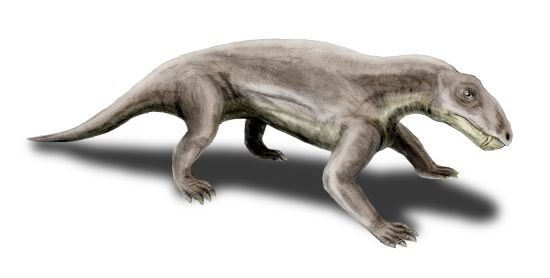 (267 mya)
(267 mya)
In Siberia one of the largest volcanic eruptions in history begins, eventually covering an area four times the size of France with lava. A massive bed of coal catches fire causing over three trillion tons of carbon to be released into the atmosphere. An entire seabed full of methane hydrate was broken down by the lava releasing massive amounts of methane into the atmosphere. Methane, a very powerful greenhouse gas, resulted in a 6 degree celsius increase in temperature at the equator. The oceans became severely depleted of oxygen and full of carbon dioxide, leading to the oceans becoming dominated by sulfate-reducing bacteria which release poisonous hydrogen sulfide. This change in ocean composition killed 96% of all marine life. The hydrogen sulfide levels in the atmosphere spiked, destroying the ozone layer, and subjecting 70% of vertebrate species to lethal UV rays. The life that survived the radiation were found with severe mutation and deformations. It is the Earth's most severe known extinction event. Virtually all evidence has been destroyed by the 200 million year cycle of destruction and recreation of earths crust. This time was known as the Permian–Triassic extinction event:
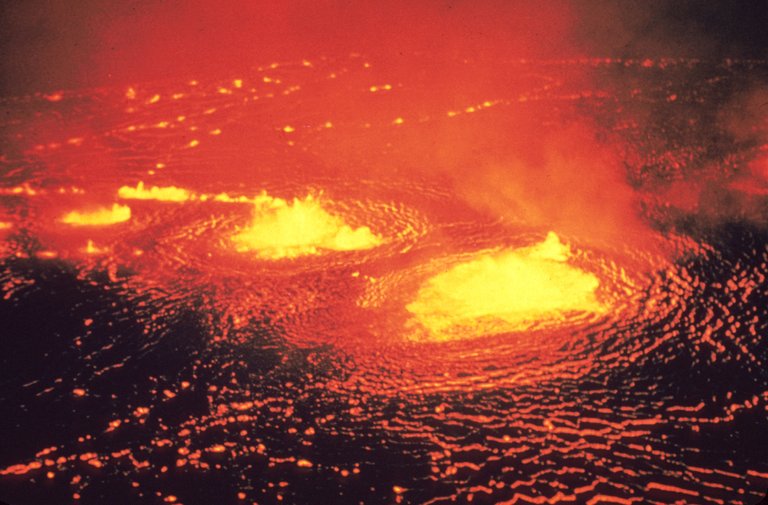 (252 mya)
(252 mya)
The extinction event dramatically increased pressure to evolve. They began to be able to generate their own body heat making them warm blooded. They also developed fur to conserve energy and be active during the night. During the arid extinction period it got especially difficult to survive, and mammal-like creatures were forced into even more evasive roles such as becoming aquatic, burrowing under ground, and even gliding between tree tops. The lack of food pressured the dog sized animal into a fox sized animal, and to change its diet back to insects and small rodents. In one such burrowing animal that represented a transitional fossil on the road to humans and other extant mammals, a unique secondary palate evolved, successfully separated the nasal passages from the rest of the mouth, allowing the it to continue eating without interrupting to breathe, an adaptation important for digestion. Parallel-fibred peripheral bone tissue are indicative that bone growth began to slow, and they bring about the assumption that the animal changed its rate of growth with age. Combine this with the greater organization of bone cells in adults, leads scientists to believe this creature grew very quickly in order to reach adulthood. Before now, changing growth patterns such as this had not been seen, establishing the idea that this new evolutionary mutation allowed it to reach peak size rapidly, a very advantageous trait. Another evolutionary advancement achieved is a segmented rib compartment. It evolved ribs with large intercostal plates that allowed for the appropriate space for the first diaphragm to assist breathing, all further aiding in the ability to breath and eat under ground. A fox sized burrowing animal is the most basal of the Epicynodontia clade, a key branching point on the way to modern humans. It is called Thrinaxodon:
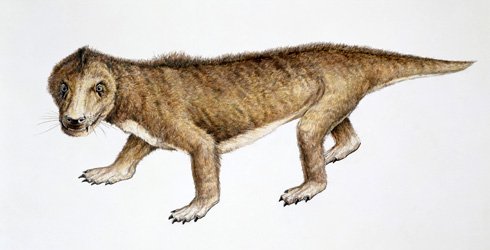 (247 mya)
(247 mya)
The rear legs evolved to be underneath the body instead of to the side and the teeth evolved to be inwardly curving. The size continued to decrease to even smaller than a fox. The beginning of the Probainognathian clade is called Lumkuia:
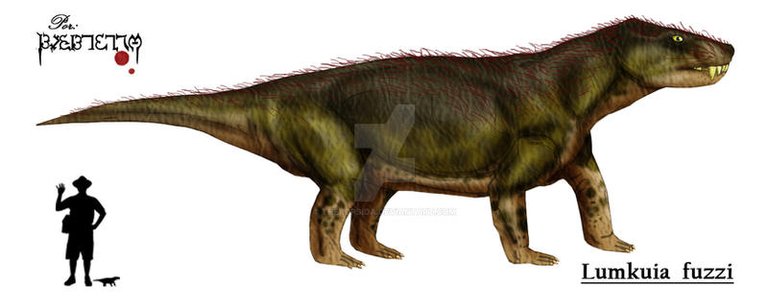 (242 mya)
(242 mya)
Previously numerous and frequently replaced, teeth evolved to appear in 2 sets, one for childhood, and the other set for adulthood. It also evolved prismatic enamel which helps spread out the force of a bite to decrease wear on teeth. It evolved sweat glands to cool the skin by evaporation. Similar to many species still alive today, it was around this time in the evolutionary history that the creature would optionally choose to keep eggs until late development instead of laying them. The egg shells thin out and eventually turn into a membrane if the egg is kept allowing the embryos to breath. Several species still alive today still retain this ability to decide to lay an egg, or give birth. No life restoration drawings have been done of this species, and a similar looking one is used instead. The beginning of the Mammaliaformes clade is called Tikitherium:
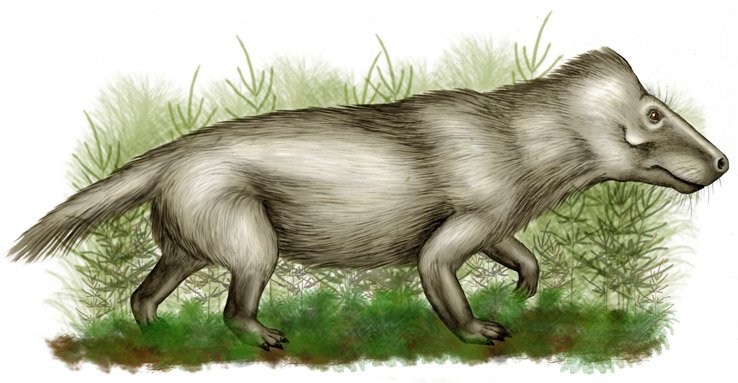 (227 mya)
(227 mya)
As Pangea began to break apart again, volcanic eruptions were also again on the rise, decreasing oxygen in the ocean. A massive asteroid hits the Gondwana supercontinent in modern day Antartica, that was so large it was believed to have cracked the earths crust and contributed to the separation of Australia from Antartica. The result is a 480 km / 300 mile crater currently underneath the Antartic ice sheet. The combination of increased volcanic activity and this asteroid resulted in the loss of over half of all life on earth, impacting land creatures the most. This time was known as the Triassic–Jurassic extinction event:
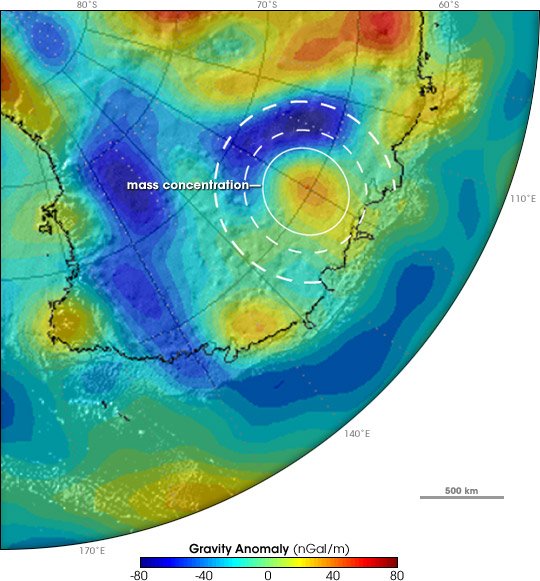 (201 mya)
(201 mya)
As with the prior extinction events, it created evolutionary pressure towards a smaller size. Again pressured by the shortage of oxygen, the heart evolves to 4 chambers and is now able to fully separate oxygenated blood. The size decreased to 10cm long. Eggs continued to be laid less often, especially in less harsh environments, and when laid required additional protection and moisture. The epipubic bone disappeared allowing room for pregnancy to continue to later and larger stages. Sweat glands on the belly of females were useful for keeping leathery eggs moist, and thus evolved to be larger, creating the precursor to milk glands. A neo-cortex developed allowing for higher levels of cognition and cooperation. The beginning of the Mammal class is called Juramaia:
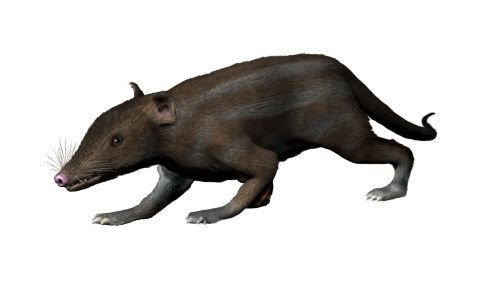 (161 mya)
(161 mya)
An asteroid about 10 to 15 kilometers (6.2 to 9.3 miles) in diameter, hits the Yucatan peninsula killing 70% of land animals and 60% of land plants. Water became extremely scarce and guarded by predators. All dinosaurs except those that could fly to water such as birds, or protect what little water was left such as crocodiles were eliminated.
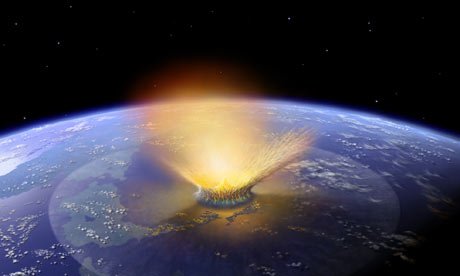 (66mya)
(66mya)
With the loss of the majority of dinosaurs, mammals became less reliant on their ability to hide and be nocturnal. Our ancestors increased from the size of a shrew to a mid sized rat. It began giving birth to only a single young at a time and egg laying stopped entirely. The first mammal placenta was formed allowing nutrients to more efficiently be transferred to the fetus than possible with a thin membrane. The placenta appears to be a relatively easy thing to evolve, and over 100 species independently evolved a placenta. In Eutherian mammals, the egg yolk sac is what evolved into a placenta. The sweat glands on female bellies, no longer used for keeping eggs moist, began producing nutrition for the young, which were still birthed not fully developed. The circulatory system continues to become more efficient and complex eventually able to direct blood down single cell wide tubes called a capillary. The first corpus callosum developed connecting the left and right hemispheres of the brain, previously separated. The result is Ukha:

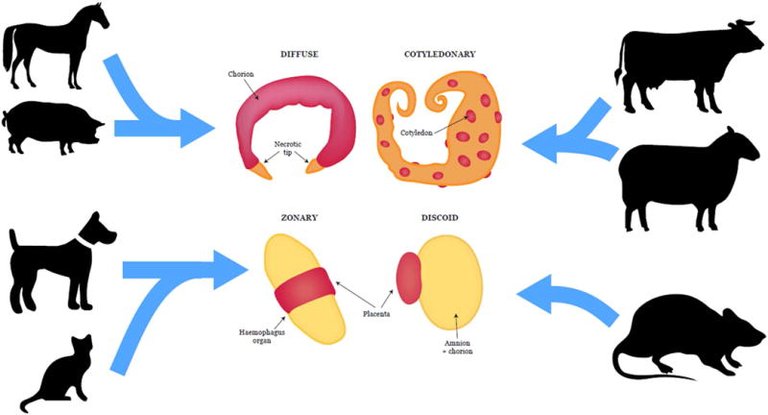 (66 mya)
(66 mya)
Feet and ankles developed to be more suited to climbing trees but still burrowed in the ground to sleep. With the loss of the vast majority of day time predatory dinosaurs, it began to be active during both the day and night. This created the first proto-primate the Purgatorius:
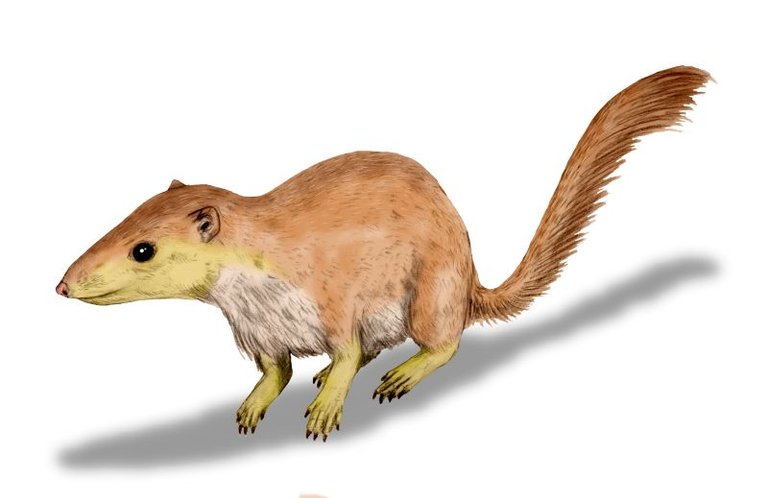 (65 mya)
(65 mya)
The rear teeth evolve to be better at grinding and crushing to be better at chewing plants as it began to move to being an omnivore. It begins to grow much larger now reaching 5 pounds. The eyes move closer to the front of the head, but not close enough for depth perception. The brain continued to grow larger exceeding that of most modern hoofed animals. The limbs continued to grow and become more suited for life in trees including strongly curved claws. Despite the increased ability to navigate through trees, it still spends around half its time on the ground. This precursor to primates is known as Plesiadapis:
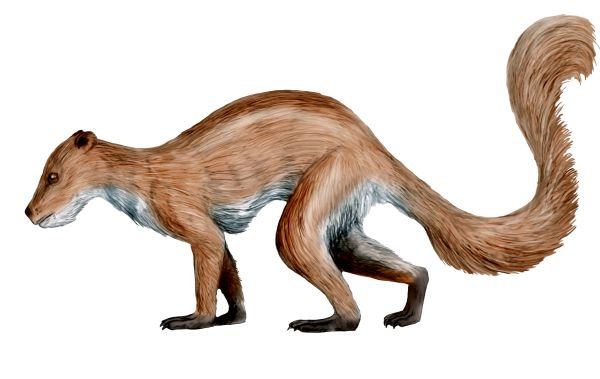 (58 mya)
(58 mya)
Eyes continued to grow larger and closer together, enabling depth perception. It began to spend most of its time in trees, making moving around a larger body in a still low oxygen atmosphere untenable, resulting in the body weight dropping to about 1 pound. As limbs became more able to manipulate the environment and reach food in small spaces, the snout/muzzle was no longer needed and was largely eliminated. This created the first primate. The basal origin of the haplorhines suborder is the Omomyidae family, of which the basal origin is the Tetonius homunculus:
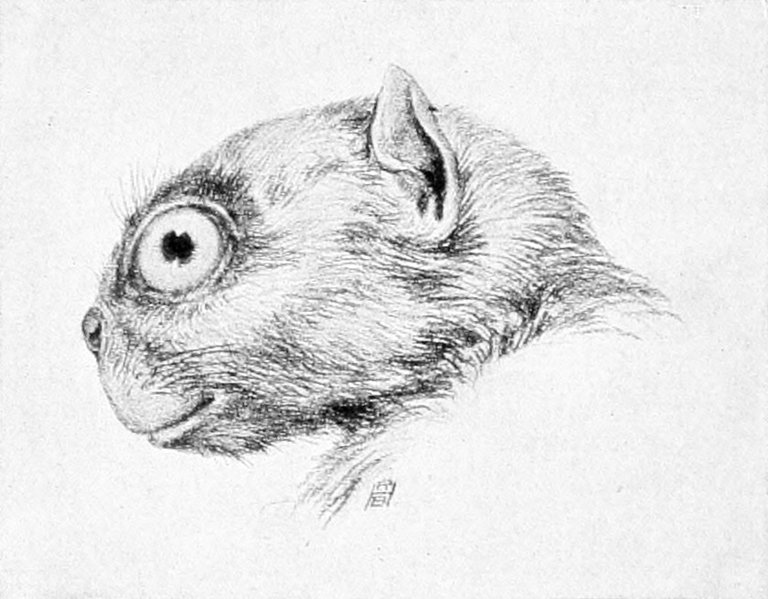 (56 mya)
(56 mya)
The amount of oxygen in the atmosphere doubles allowing for much larger brains, and fetuses both of which have large oxygen requirements. Also at the same time global temperatures warmed up by 7° C / 12° F. After this temperature increase, there were crocodiles in the Arctic, pine forests in the Antarctic, and palm trees in Wyoming. All polar ice melted. As a consequence, sea levels rose to 330 feet (100 m.) higher than today:
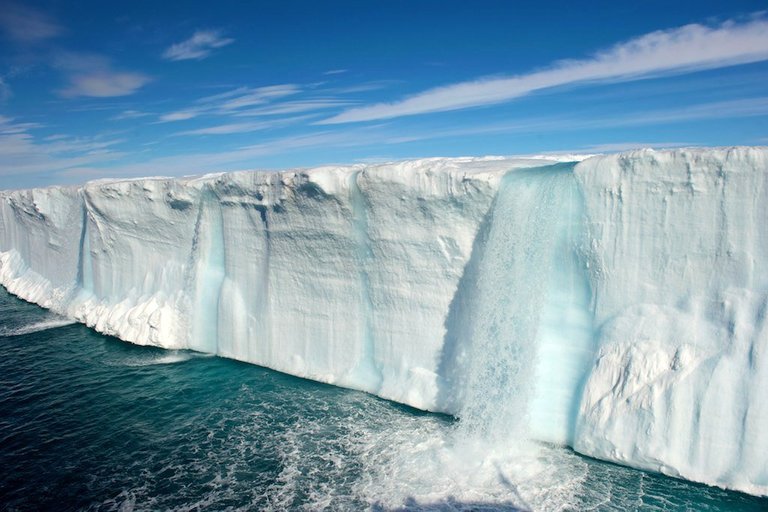 (50 mya)
(50 mya)
As it transitioned to be less active at night, large eyes and sensitive smell reception was no longer needed, and both areas became smaller and less capable. Cheek bones formed for the chewing muscles to attach to. Claws, less useful for life in trees than nails are, were in the process of flattening to nails. The exception is the pointer finger which retained a claw for the purpose of dealing with bugs in fur. The ability to see additional colors began to develop with more cone types. The ability to use muscles faster than oxygen is available for quickly covering short distances becomes more popular. Muscle fibers that can produce the enzymes needed to reduce glucose to pyruvate and pyruvate to lactic acid, become more popular. A life restoration has not been created, and instead the image below is a very similar species. The basal creature of the Simian infraorder has not been confirmed, the most likely canidate is Amamria tunisiensis:
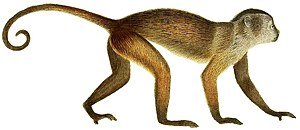 (40 mya)
(40 mya)
As the evolutionary pressure to be more adept at life in tress continues, both hands and feet evolve the ability to fully wrap around objects like branches. Typically swinging from branch to branch to move around, they evolved more range of motion in the shoulder joint. Tails began to get shorter. The basal member of the Catarrhini parvorder is unknown, however the members of this parvorder are simply Simians that did not move to South America, and thus did not evolve muscular tails:
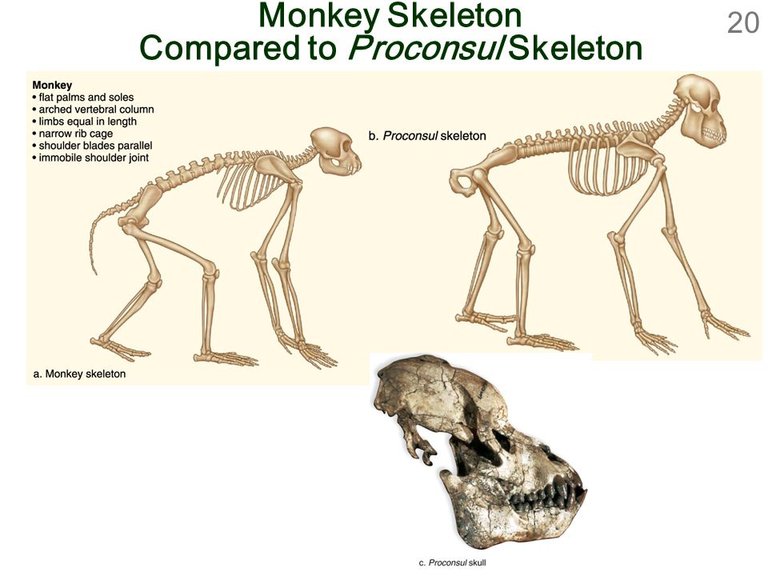 (30 mya)
(30 mya)
The species that led to humans continued to evolve in eastern Africa. Tails fell out of use completely, with all that remains a tail bone. The rib cage became more broad, and the spine less flexible. The head became less wide with more depth instead. The switched from plants and insects to mostly fruit. They no longer move around by flinging from branch to branch but still travel branch to branch with even longer and stronger arms. They grew to weigh around 65 pounds. Social behavior begins and they become more cooperative. The cooperative behavior allowed them to groom each other, thus eliminating the need for a grooming claw which flattened into a nail. The leading candidate for basal Hominoidea superfamily, shared by by humans and gibbons is the Proconsul:
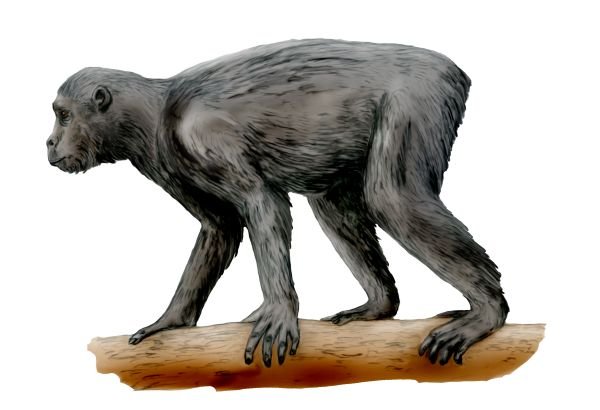 (23 mya)
(23 mya)
As the diet switched more to hard fruit, the enamel on teeth thickened, and the snout extended a small amount. A leading candidate for the basal member of the Hominidae family, shared by both humans and orangutans, is the Afropithecus:
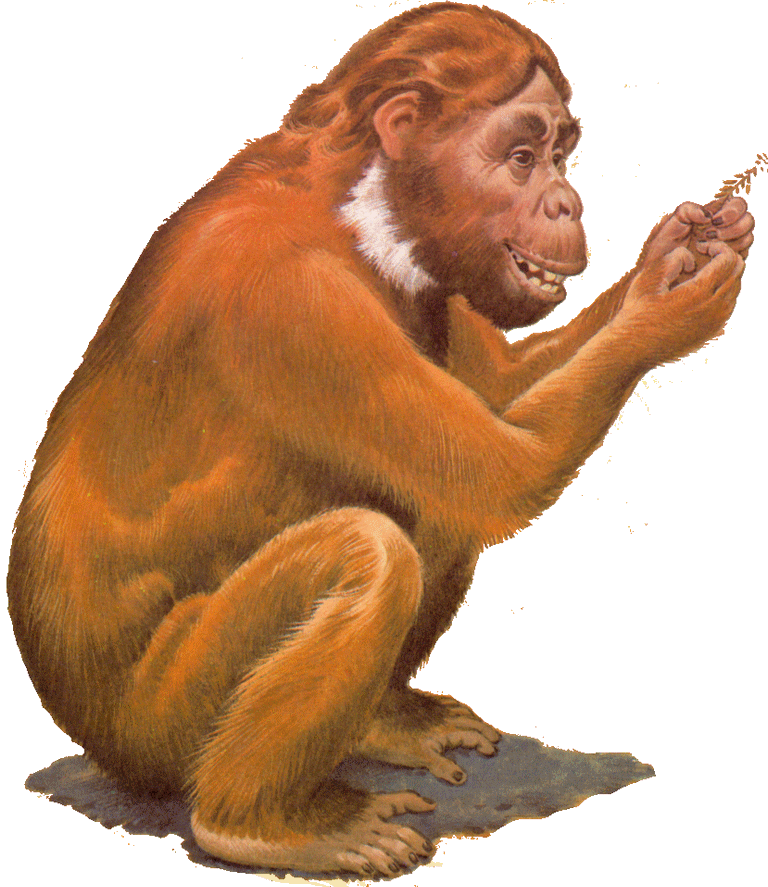 (17 mya)
(17 mya)
Climate changes in east and central Africa reduce forest coverage until what remains is patches of trees with flat open land in between that had to be traversed. This increased the need for the ability to come down from trees and travel longer distances on the ground:
 (11 mya)
(11 mya)
The head became thinner, along with many other minor changes as it continued its evolution in Africa. The basal member of the Homininae subfamily, shared by both humans and Gorillas, is Nakalipithecus:
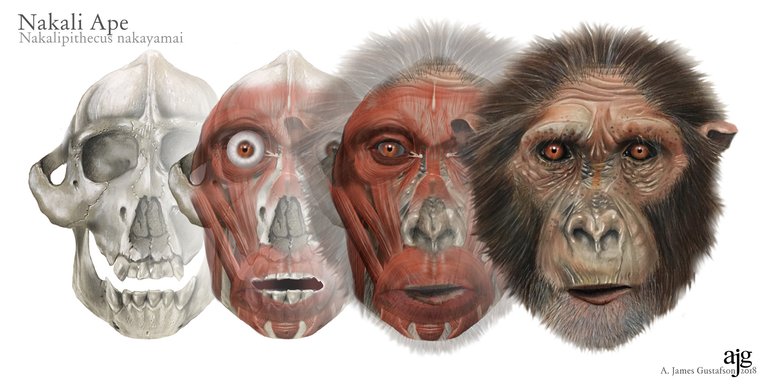 (10 mya)
(10 mya)
The bone structure and placement evolved to partially allow walking on two legs, though it was likely not very efficient and was aided by fists on the ground. The basal member of the Hominini Tribe, shared by both humans and Chimpanzees, is Sahelanthropus:
 (7 mya)
(7 mya)
The canine teeth decreased in size. The brain grew to the size of a modern day chimpanzee. The bone placement and structure continued to support more efficient movement on two legs, and bipedal movement became the primary method. Moving from branch to branch using only the upper arms started to become less common. Aggression behavior between males decreased. Pair-bonding began to increase the number of exclusive sexual relationships, and increased parental role from males. Vocal cords become developed and complex enough for the first time to support speech. Until now most new species were clean splits, however, DNA evidence shows interbreeding continued between more chimpanzee-like Hominini tribe members and more human like tribe members until 5 mya. The primary difference that began to lead to a rift between the types of Hominina was the ability of the feet to grasp branches, which the lineage that led to humans had less of. Ardipithecus, a member of the Hominina Alliance:
 (6mya)
(6mya)
As Hominini become more widespread, a new tree climbing 120 kilograms (260 lb) Jaguar-like predator starts to become popular in eastern Africa. Carbon isotope ratios in its teeth, indicate it killed more Homini than any other predatory animal. The enemy of Homini, the Megantereon:
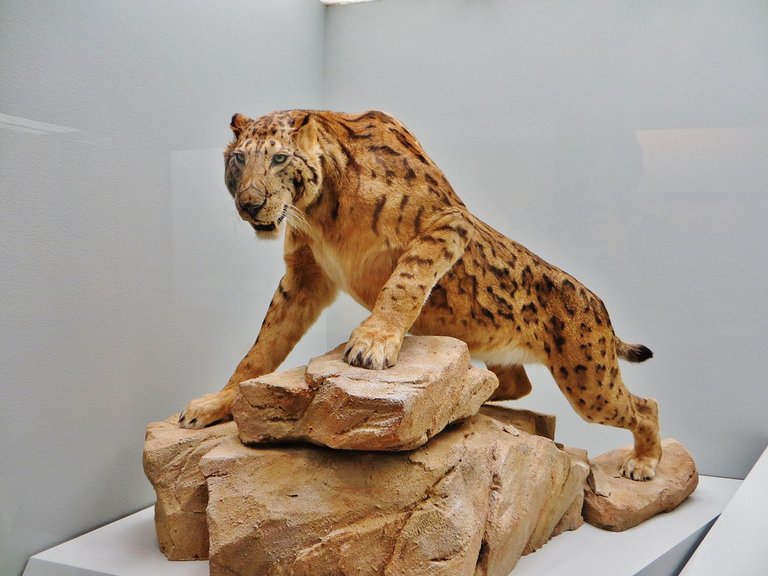 (5 mya)
(5 mya)
The ability to grasp branches using feet is lost and interbreeding with the tree faring chimpanzee lineage came to a stop. It continues to lose its ability to efficiently move around in trees, and now is almost entirely bipedal. The pelvis, feet, and knees undergo significant changes to further suit bipedal movement. It was able to walk and run at nearly as fast as modern humans. Canine teeth and molars continued to decrease in size. The mating behavior became even more monogamous. The result is Australopithecus Afarensis:
 (4 mya)
(4 mya)
The face continued to get flatter. The habitat further transitioned towards open ground as opposed to trees. The molars continued to get smaller, and the mouth deeper. The nose began to face downward more. The first use of tools began with the use of sharp rocks to aid in cutting meat off of animals. The result is Kenyanthropus:
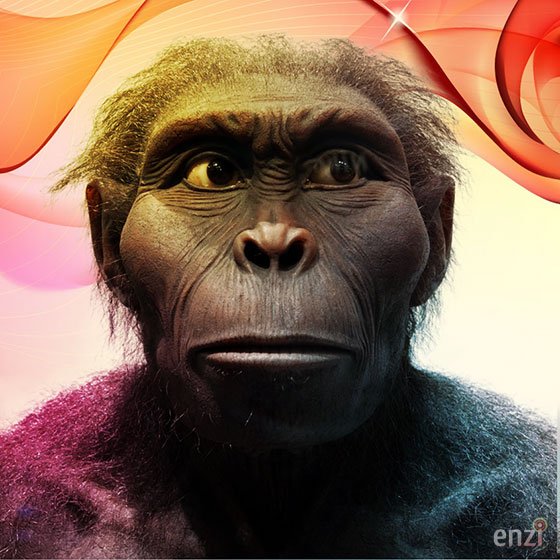 (3.5 mya)
(3.5 mya)
The loss of body hair begins. The face becomes even flatter. The brain becomes 50% bigger. They continue to get better at using rocks to cut up food, but have not yet tried using tools to hunt or defend themselves from Megantereon. At 4 feet tall, the result is the first of the Homo genus, the Homo Habilis:
 (2.1 mya)
(2.1 mya)
For 1 million years, the Homo Habilis in Africa had as competition the similar Paranthropus Boisei which subsisted on nuts and hard fruit, and did not experience an increase in brain size like Homo Habilis. Eventually, their inability to use tools or eat a varied diet led to losing the competition and eventually led to extinction:

Walking transitions from heel to toe instead of the opposite. The brain increases again, this time to 30% larger. The height increases from 4 feet to 5 feet. The difference between male and female body size decreases to only 25%. They begin building hunting weapons, axes, and floating rafts. They also invented language. They were able to walk further than any land animal on the planet, allowing determination to always result in food. The ability to hunt and kill large animals as well as fend off predators like the Megantereon, as well as raft building led to the rapid spread across the earth. It is called Homo Erectus:

Divergent subgroups of Homo Erectus adapted for living outside Africa begin to appear. The first use of fire and pottery begins:

The brain size increases by another 30% making them almost as large as modern humans. The continued adaptation to local environments happens, causing fairly drastic differences. Neanderthal, which was adapted for cold climates and had a brain the size of modern humans. They begin to bury their dead. The ear becomes nearly identical to modern humans. Spears became a common weapon. The result is the ancestor to both Homo Sapiens and Neanderthals, Homo heidelbergensis:
 (0.8 mya)
(0.8 mya)
Cross breeding between Neanderthals and Homo heidelbergensis begins as soon as the Neanderthals appear:
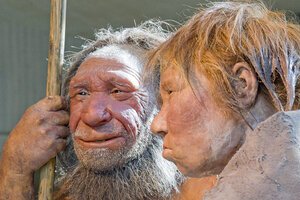 (0.5 mya)
(0.5 mya)
The forehead became vertical, brain size increases by 10%. Teeth continued to become smaller. The chin became more prominent. Adaptability to high altitude increased. The difference between male and female body size decreases to only 12%. The population reaches around 50 thousand. The result is Homo Sapiens:
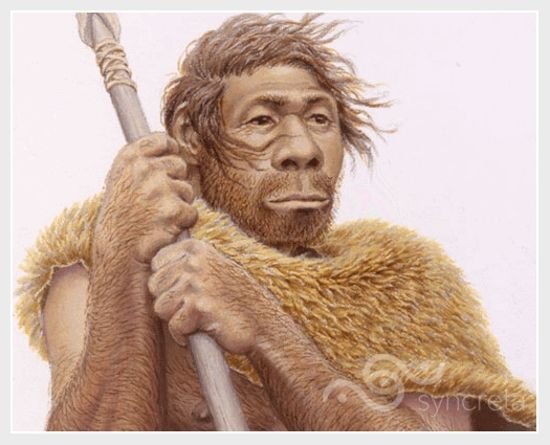 (0.35 mya)
(0.35 mya)
Homo Sapiens further begin to evolve to fit their local environment and split into central African and south African subspecies. In south Africa, heights regularly reached over 7 feet tall, while in central Africa they remained around 5 feet tall:
 (0.25 mya)
(0.25 mya)
The ability of Humans to hunt with tools, their rapid spread across the planet, and the inability of large megafauna like the Mammoth to escape, led to the extinction of all megafauna in Africa. This is the beginning of the Holocene extinction: 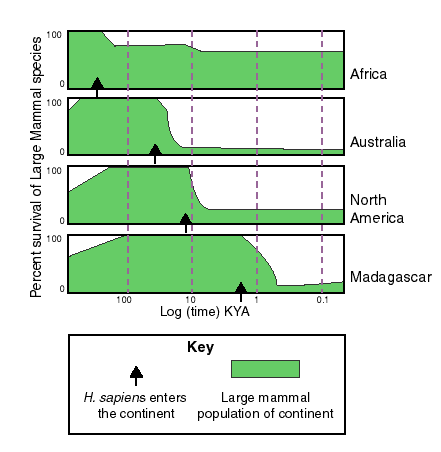 (0.15 mya)
(0.15 mya)
The central African subspecies splits into central, eastern, and western African subspecies. (0.1 mya)
World population of humans reaches around 200 thousand. The western African subspecies splits to create the Eurasian Homo Sapiens (0.08 mya)
Toba, an enormous super-volcanic eruption in Indonesia erupts causing a global winter lasting decades and wiping out 90% of humans. For a brief time, Neanderthals had an evolutionary advantage over Homo Sapiens:
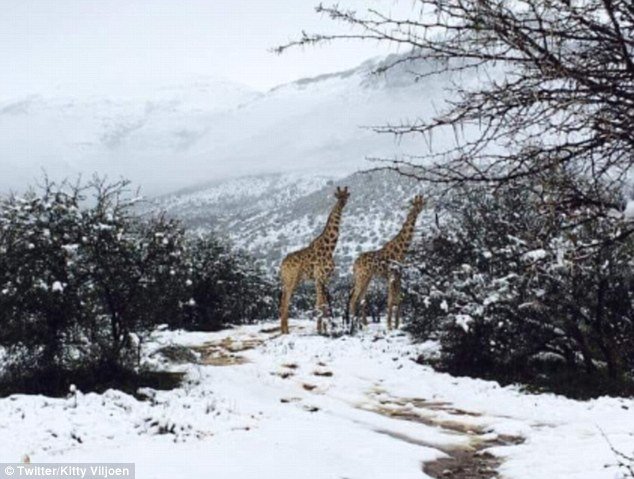 (0.07 mya)
(0.07 mya)
All subspecies of Homo Sapiens begin mild interbreeding (0.05 mya)
Cross breeding between Neanderthals and Homo Sapiens stops when the Neanderthals go extinct. (0.04 mya)
Lighter skin develops in Europeans and East Asians:
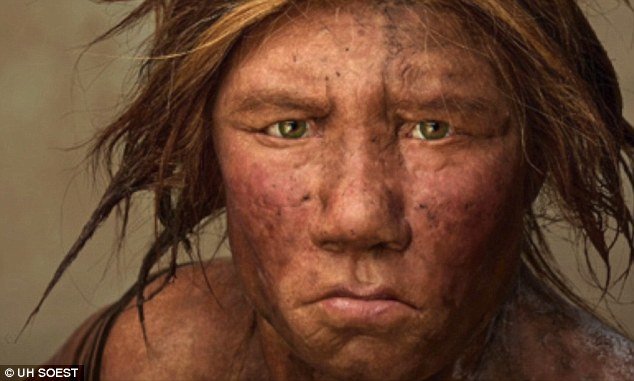 (0.03 mya)
(0.03 mya)
Inuit adaptation to high-fat diet and cold climate:
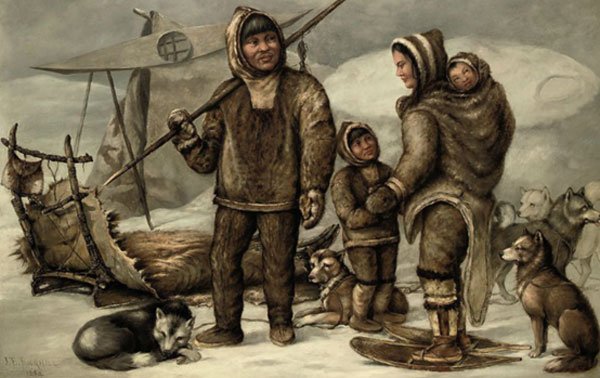 (0.02 mya)
(0.02 mya)
The population of humans on earth reaches 1 million. The ability drink unprocessed milk past childhood begins to appear in humans, largely in Europe:
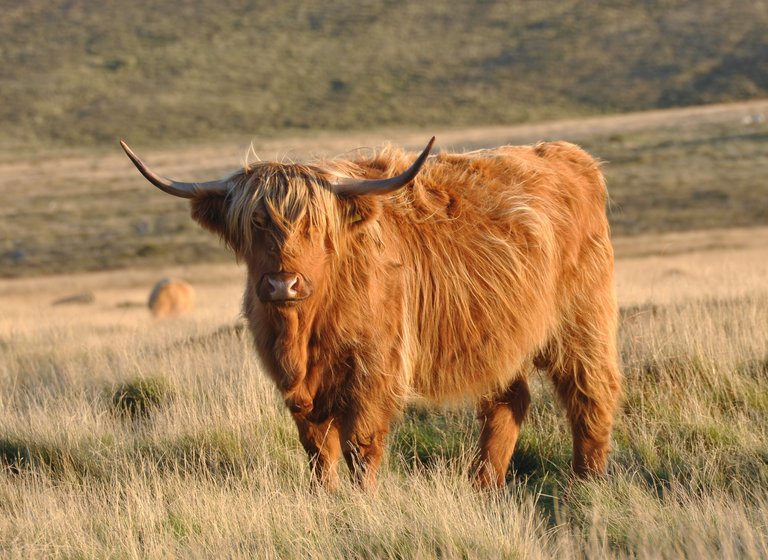 (0.015 mya)
(0.015 mya)
As the world human population reaches around 5 million, they finish hunting all megafauna on earth to extinction including the successor to the Megantereon called Smilodon which had a diet largely of megafauna and humans:
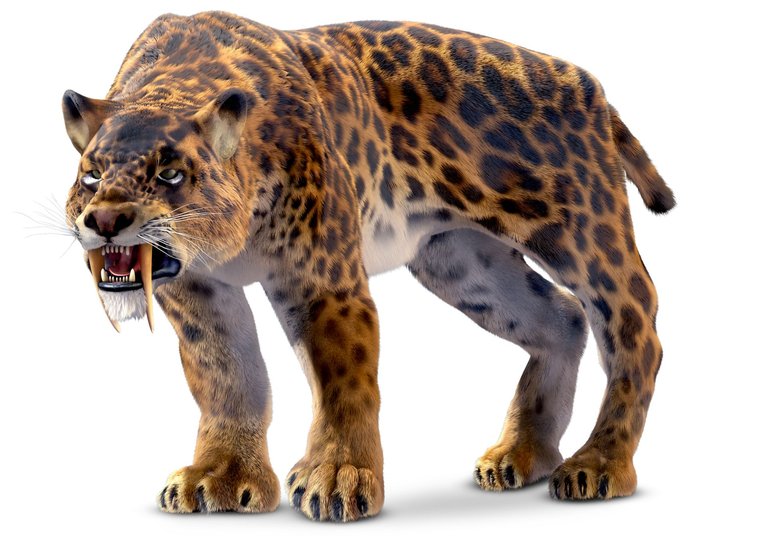

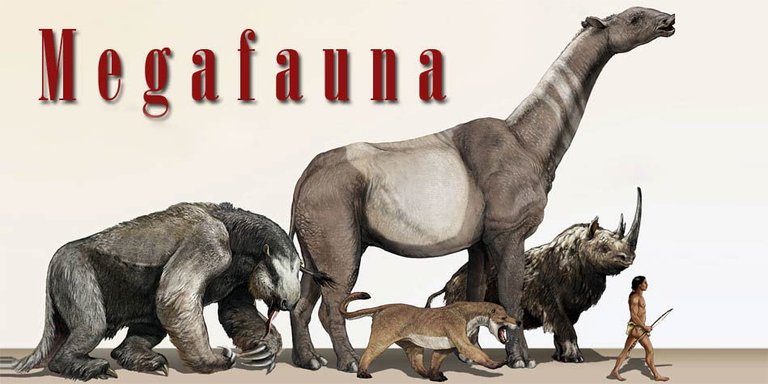 (0.01 mya)
(0.01 mya)
10 thousand years later, we arrive at modern humans. Pictured below are the average faces from different regions of the planet:
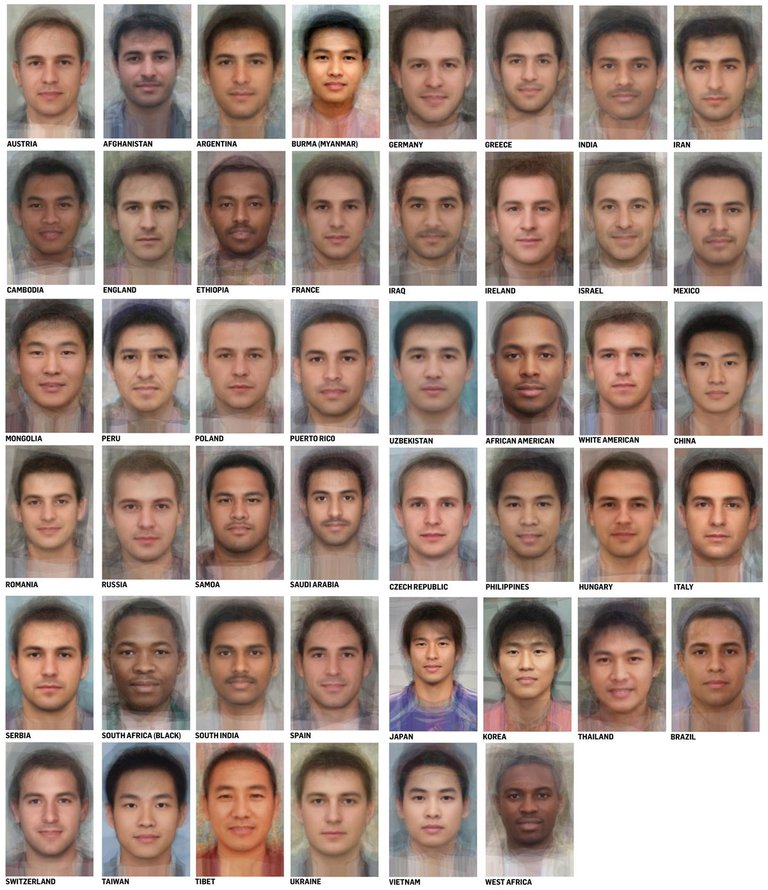
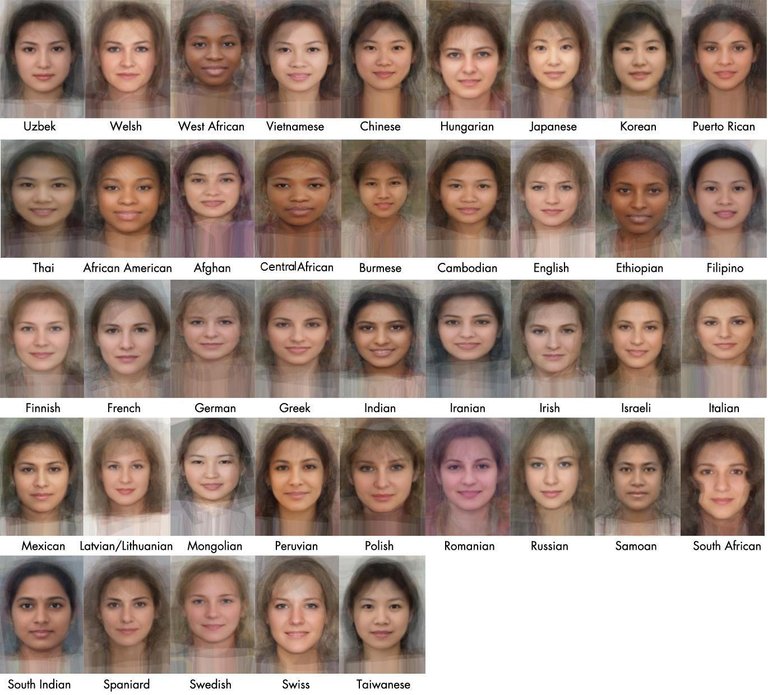
Animated:
https://i.imgur.com/zWMGZVz.mp4(600 mya - Now)
This post was shared in the Curation Collective Discord community for curators, and upvoted and resteemed by the @c-squared community account after manual review.